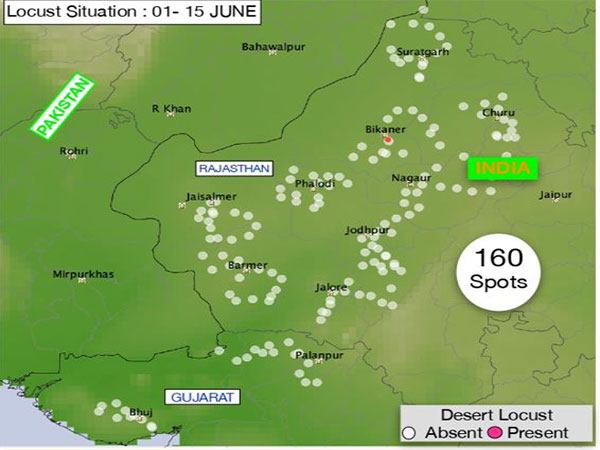New Delhi [India], June 26 (ANI): In a piece of good news for farmers, who are busy sowing Kharif crops presently, a survey has revealed that the country continues to be free of locusts, which had emerged as a grave threat to farm output a couple of years back.
During the routine survey conducted by the Locust Warning Organization-Jodhpur which is under the Union Ministry of Agriculture and Farmers Welfare, the country was found free from desert locust activities during the first fortnight of June. Just a solitary mature adult was seen in Surdhana of Rajasthan’s Bikaner district on June 13.
A total of 160 spots, mostly in Rajasthan and Gujarat, were covered while conducting the field surveys, the latest bulletin on the locust situation said.
“India is free from gregarious locust activities,” the Locust Warning Organization-Jodhpur said.
Breeding of such grasshoppers too was not reported and the presence of locusts is unlikely upto the next fortnight, it said.
Locusts are voracious in nature and are known for their vegetation-destroying abilities and their large-scale presence may potentially threaten food security.
“During Locust Surveys, soil moisture was observed dry at some spots and wet at others. As per rainfall estimation map for 1st decade of June, moderate rainfalls at Jalore, Jodhpur, Phalodi, Bikaner and Suratgarh area whereas, low to moderate rainfalls in other areas except Bhuj. During the surveys, Vegetation was found green/ greening except Jalore, Bhuj, Nagar and few spots of Jodhpur,” the bulletin’s weather and ecology section said.
Significantly, the locust menace was at its worst in Pakistan in early 2020, when the country declared the menace a national emergency.
At the same time, India too witnessed a large-scale locust incursion in several Indian states such as Rajasthan, Gujarat, some parts of Punjab, Madhya Pradesh, Uttar Pradesh, and Maharashtra.
Swarms of locusts were first spotted in India in early April, in the districts of Rajasthan bordering Pakistan. They damaged and destroyed a large portion of crop area but were limited mainly to Rajasthan.
Meanwhile, farmers in India sowed kharif crops across 129.53 lakh hectares, as against 135.64 lakh hectares during the same period last year.
Paddy, moong, bajra, maize, groundnut, soyabean, and cotton are some of the major kharif crops.
India has three cropping seasons — summer, kharif, and rabi.
Crops sown during June-July and harvested in October-November are kharif. Crops that are sown during October and November and the produce harvested from January-March depending on maturity is Rabi. Crops produced between rabi and kharif are summer crops. (ANI)










